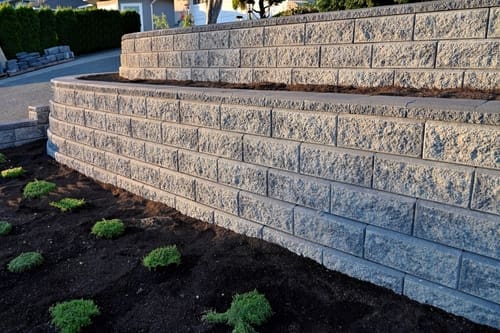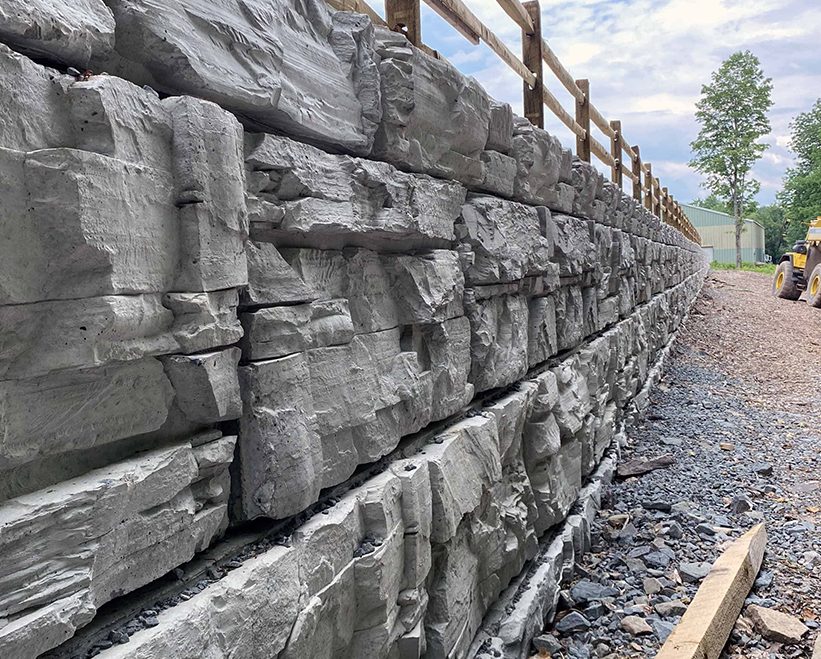A Complete Guide to OKC Precision Retaining Walls for home landscaping success
A Complete Guide to OKC Precision Retaining Walls for home landscaping success
Blog Article
Trick Considerations for Building Reliable Retaining Walls in Your Backyard
When you're considering constructing a keeping wall in your yard, it's important to assume regarding a number of essential factors. The wall's function, the materials you'll utilize, and the particular soil conditions can all affect its effectiveness and long life. You'll additionally need to browse local building ordinance and plan for appropriate drain. Yet exactly how do you guarantee your design not only satisfies these requirements but also improves your landscape? Allow's discover the essential actions together.
Comprehending the Function of Your Retaining Wall
When you think of developing a keeping wall surface, consider its major objective: maintaining soil and protecting against erosion. Retaining walls give necessary assistance for sloped landscapes, assisting to preserve dirt honesty. You'll discover they're vital in areas where water runoff might or else remove soil, bring about costly repair work and landscape damages.
By holding back planet, these walls create degree surfaces for gardens, outdoor patios, or paths. This not only boosts your backyard's aesthetics however additionally promotes far better drainage, minimizing water merging in unwanted locations. If you're managing steep slopes, a well-constructed retaining wall surface can prevent landslides, making certain safety for you and your residential or commercial property.
Eventually, recognizing the function of your retaining wall will lead your design decisions and assist you develop a functional, durable framework that satisfies your demands. Take a moment to assess your landscape; it'll pay off in the lengthy run.
Choosing the Right Products
When choosing products for your retaining wall, you'll wish to take into account resilience, aesthetic appeals, and expense. Each factor plays an essential role in guaranteeing your wall surface stands the test of time while looking terrific and suitable your budget plan. Let's check out how to make the very best options for your task.
Material Sturdiness Variables
Choosing the best materials is vital for the durability and effectiveness of your retaining wall, given that their toughness straight influences the wall's ability to withstand ecological tensions. Start by considering your neighborhood climate; products like concrete and rock stand up to moisture and temperature level changes well. If you live in a location susceptible to hefty rains, opt for products with great drain properties, like gravel or porous blocks, to avoid water build-up.
Additionally, believe regarding the soil problems on your building. Some materials execute better in certain soil kinds, so it is necessary to match them as necessary. Be conscious of possible wear from bugs or erosion. Selecting long lasting products guarantees your retaining wall stands solid, shielding your backyard for years to come.
Visual Layout Selections
Long lasting products not only ensure your retaining wall's structural honesty but additionally play a crucial duty in its visual charm. When selecting the best products, consider just how they enhance your landscape. Natural stone supplies a timeless, rustic look, while concrete blocks can supply a smooth, modern surface. You may additionally consider making use of timber for a cozy, natural feeling. Color and structure matter, as well; choose shades that harmonize with your home and garden. Don't ignore the wall's form-- rounded walls can produce a softer look, while straight lines can really feel extra structured. By thoroughly choosing materials that straighten with your visual vision, you'll improve your exterior room while ensuring your wall surface stands solid against the components.
Cost-Effectiveness Evaluation
Choosing the best products for your retaining wall surface isn't almost aesthetic appeals; it's additionally crucial for your budget plan. When choosing materials, consider both upfront expenses and long-term sturdiness. For circumstances, cinder block could be more expensive at first, however their durability can save you cash on fixings. On the various other hand, timber can be a lot more budget friendly however may need substitute sooner.
Do not fail to remember to factor in upkeep prices. Some materials, like natural rock, can add charm and call for much less maintenance, while others could need routine therapies
Inevitably, consider the benefits and drawbacks of each choice against your budget plan and the wall's intended function. Investing wisely in materials now can stop expensive problems down the road. Pick materials that stabilize expense and performance efficiently.
Analyzing Soil Conditions and Drainage
As you start your task, assessing dirt problems and drain is vital for the success of your retaining wall. Start by checking out the type of dirt in your backyard. Sandy dirt drains well however does not have security, while clay dirt can maintain moisture, bring about press on your wall surface. Check the dirt's dampness web content by digging a little hole and observing just how rapidly it dries out.
Following, assess the slope of your backyard. If water naturally streams towards your wall surface, you'll require to carry out a water drainage option to avoid erosion and stress buildup. Think about installing perforated pipelines or gravel backfill behind the wall to help with water drainage.
Finally, observe any type of nearby trees or greenery; their roots can influence dirt security. By recognizing your dirt problems and implementing proper drain, you'll develop a solid foundation for your retaining wall that stands the examination of time.
Adhering To Local Structure Codes
Before you start developing your retaining wall surface, you need to research study local regulations to ensure compliance. It's necessary to recognize what allows you should obtain, as this can save you from pricey penalties or having to redesign your job. Taking these actions seriously will aid you construct a risk-free and effective framework.
Research Study Local Regulations
Understanding local regulations is important when intending your retaining wall surface project, especially since building codes can vary significantly by area. Begin by talking to your regional structure division or community to find out about specific needs. Seek standards on wall surface height, materials, water drainage systems, and architectural integrity. Lots of areas have constraints on the kinds of this link materials you can utilize and just how high you can develop. You'll also intend to take into consideration the zoning regulations that may affect your job. Disregarding these policies can cause expensive fines or the need to redesign your work. By doing your research study upfront, you can guarantee your retaining wall surface fulfills all required codes and blends effortlessly into your yard.
Acquire Required Licenses
When you have actually researched regional laws, the next action is to obtain the essential permits for your retaining wall surface task. This process assurances your wall abides by building codes and security standards. Reach out to your regional building authority to discover what permits you require. They may need particular plans or design analyses, particularly for bigger walls. Be prepared to submit comprehensive illustrations, including measurements and products. Do not fail to remember to examine if your task affects water drainage or surrounding buildings, as these variables could require added permits. Safeguarding the appropriate approvals can save you from expensive penalties or having to dismantle your wall later. Remember, adhering to the policies now will bring about a smoother building and construction experience.

Planning the Layout and Appearance
As you start preparing the layout and visual appeals of your retaining wall surface, consider just how it will certainly balance with the surrounding landscape. Think of the products you'll make use of-- stone, brick, or concrete-- and how they'll match your home's design and the natural environments in your backyard. Pick shades and textures that mix seamlessly with existing functions like patio areas, paths, or gardens.
Next, envision the wall's shape and height. Rounded walls can soften an inflexible landscape, while straight lines may share a much more contemporary look. Do not forget to include plants and greenery around the wall surface for an all-natural touch; this can boost its charm and integrate it right into the environment.
Finally, bear in mind capability. Your style ought to not only be aesthetically pleasing yet additionally serve its purpose effectively. By thoughtfully preparing these components, you'll create a maintaining wall surface that improves your backyard's charm while fulfilling its architectural duty.
Computing Elevation and Thickness Demands
To develop a tough retaining wall surface, you need to accurately compute its height and thickness needs based on the soil problems and the elevation of the incline it will certainly support. Start by examining the incline's angle and the sort of soil, as various dirts put in varying amounts of stress.
For walls over four feet high, consider a density of a minimum of 12 inches. If the wall is taller, enhance the thickness proportionally to preserve security.
Next, compute the height of the wall surface by measuring the upright distance it requires to keep. For every foot of height, you ought to usually prepare for a density of one-third of the wall's elevation.
Always bear in mind to account additional hints for extra variables like water drainage and backfill, which can influence your wall's style. Appropriate calculations currently guarantee your retaining wall surface stands solid and lasts for many years to find.
Upkeep and Longevity Considerations
While keeping your retaining wall could feel like a low concern, overlooking it can lead to substantial issues with time. Regular assessments are important; check for cracks, protrudes, or any type of indications of water damages. Resolving these problems early can conserve you from costly repair services down the roadway.
Keep an eye on water drainage systems, as well. Blocked drains can trigger water to construct up, putting in pressure on your wall and jeopardizing its security. Clear particles and assurance appropriate flow to preserve longevity.
You might also wish to review securing your wall surface to secure it from moisture and weathering. Relying on the product, this might call for reapplication every few years.
Last but not least, landscaping around your wall can sustain its honesty. Avoid planting large trees nearby, as their roots can weaken the foundation. With aggressive upkeep, your retaining wall can offer you well for several years to find.

Often Asked Inquiries
Can I Build a Retaining Wall by Myself, or Should I Hire an Expert?
You can definitely develop a preserving wall surface yourself if you have the right devices and knowledge. Working with a professional assurances it's done appropriately, particularly for larger or even more complex structures. Consider your skill level before choosing.
What Are the Many Common Blunders Made When Building Retaining Walls?
When constructing retaining walls, you may overlook appropriate water drainage, miss making use of the ideal materials, or neglect support. These usual errors can result in architectural failing, so take your time and plan very carefully to prevent problems.
How Do I Know if My Retaining Wall Requirements Reinforcement?
You'll know your retaining wall surface needs support if you notice fractures, leaning, or protruding. Look for water merging behind it or soil erosion near the base. Address these indicators without delay to stop further damages.
What Plant kingdom Appropriate for Landscaping Around a Retaining Wall?
When landscaping around a keeping wall, take into consideration utilizing low-maintenance plants like succulents, decorative grasses, or sneaking ground covers - OKC Precision Retaining Walls. They'll flourish in those problems and add beauty while protecting against dirt erosion around your wall surface
How Can I Protect Against Erosion Around My Retaining Wall?
To stop disintegration around your retaining wall, you can grow ground cover, use mulch, and install water drainage systems. Consistently look for this water buildup and adjust landscaping to reroute overflow far from the wall.
Report this page